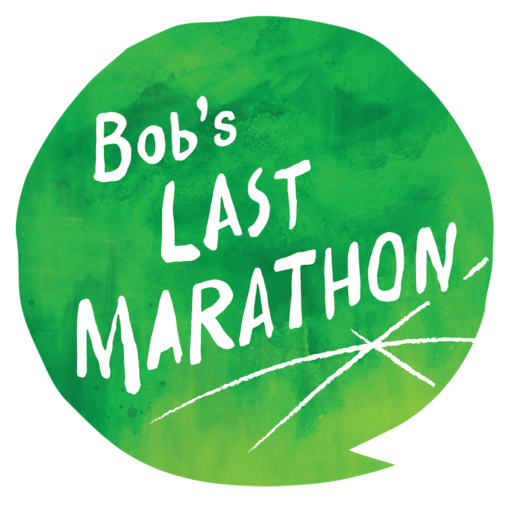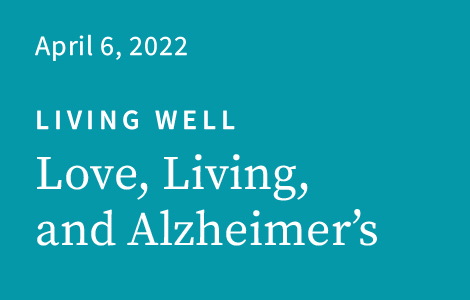Transcript
Love, Living, and Alzheimer’s
Amy Bloom’s much publicized book, In Love, and her story about her and her husband’s decision to end his life following the diagnosis of Alzheimer’s disease shocked, saddened, bewildered, and disturbed me. Images from the years following my own husband Bob’s diagnosis, the long, unpredictable journey—punctuated by anguish and despair at times, and unexpected calm and joy at others—flashed before my eyes, as I realized that I would not trade our times together for anything. While I would not think of those years as the best years of our lives together, we shared magnificent moments feeling the deep love we had for each other, the pride in our children and grandchildren as they rallied and gave us their unconditional support, and our gratitude to all the people who made this journey possible—the clinical team, the home care staff, the social workers and support group leaders at day care and the Alzheimer’s Association, the music, art, speech, physical and cognitive therapists, exercise instructors, drivers, and friends. If there is one thing I want the world to know, it is that an Alzheimer’s disease diagnosis does not need to spell an end to quality living, and that help and support are out there for those of us who choose to meet the challenge.
So how did we do it? How did we live the Alzheimer’s journey through all the heartbreaks?
It took us a little while—perhaps a few months—but our first step was recognizing and acknowledging the diagnosis. I remember saying to Bob, when we finally came to terms with it, when we signed up for a six-week support program for newly diagnosed patients: “We start our Alzheimer’s support group next week. The key word is Alzheimer’s. This is your diagnosis. This is what we are going to face together—the biggest challenge in our lives. It’s going to be tough, but we can do it.” Just a few days before that, I had visited our local senior community center—Avenidas, in Palo Alto, California, where we lived—and spoken to Vicky, a social worker familiar with the issues of living with dementia. And it was Vicky who recommended the support group and reserved places for us. The group gave us an opportunity to meet people like us, to share our feelings of dismay and confusion, gather information about what lay ahead, and ask the inevitable question, what do we do now? I found the experience of talking to others like us both encouraging and educational, and the extrovert in Bob enjoyed meeting people and chatting with them. We ended up attending support groups pretty much through all the years of his illness. All the support groups we attended were free of charge, run by the Alzheimer’s Association. Since the start of the COVID-19 pandemic, many support groups have been available online, making participation easy.
Vicky also recommended a care manager. Sometimes called a case manager, the care manager is someone experienced in guiding families as they face the challenges of dementia, elder care, or serious illness. Following an initial assessment of our situation—Bob’s diagnosis, my employment status, access to family members who could help, our lifestyle and finances—our care manager gave me an overview of what lay ahead in terms of caregiving needs, which would surely increase with cognitive decline. She talked about resources available in our area (such as day care), and longer-term needs such as advance health directives and estate planning. Care managers are consultants, paid by the hour, so I made sure I planned how I would use her time based on our budget as well as our needs. Over the years, our care manager was my sounding board on decisions—such as starting day care, choosing day care, and weighing the tradeoffs of moving Bob to a care facility or keeping him at home. She also interviewed potential home care staff and guided me in training them. At my request, she would visit the day care center to observe Bob—something only professionals are permitted to do—and report on his progress to me.
Key to keeping Bob healthy and feeling well physically was the clinical team. Bob had an excellent primary care physician who had known him for 20 years before the diagnosis, and Dr. Mebane was there every step of the way to direct and coordinate his overall care. I especially appreciated his readiness to respect and support Bob’s neurologist’s decisions. With my consent, we tried—successfully, I might add—to include experimental approaches to Bob’s treatment. This was possible even though Bob’s neurologist was in a different health care system, 3000 miles away. In turn, Dr. Arnold, Bob’s neurologist, gently reminded me, when the time came, that he had done everything he could for Bob, and that Bob’s primary care physician was my most important resource for Bob’s care going forward. Dr. Arnold also introduced to me what became a guidepost—the five key elements of dementia care. Medication. Diet. Exercise. Social interaction. Cognitive therapy. I lived by these five key elements as I made decisions for Bob, every day.
All of this—healthy daily routines, participating in support groups, making sure Bob received the best care possible—would have been far more difficult if I hadn’t been at my best, physically and mentally. I became a champion of self-care, knowing in my heart that the time I invested in staying well was time well spent, for me and for Bob. I made exercise, time for myself, music, hiking, and enjoying my grandchildren the highest priority. Putting ourselves first is especially challenging for caregivers because of the incessant and often unpredictable demands of dementia, but it makes all the difference. In our roles as wife and mother, women like me are used to making sacrifices for our family, giving priority to their needs. And then there are practical barriers—such as having people to help with care while we take time off. Recently, Bob’s Last Marathon devoted a podcast to the topic of overcoming barriers to self-care. In that podcast, Dr. Barry Jacobs, noted psychologist and family therapist, and Felicia Greenfield, Executive Director of the Penn Memory Center, offer suggestions on asking for and getting help and, importantly, adjusting our mindset to give self-care the time and space it needs.
I am glad the option to end Bob’s life never entered our heads as we grieved over the news of his diagnosis. And that I am here, today, to give testimony to the life and love that are possible for people diagnosed with Alzheimer’s disease. Was that worth it—the hard work, the sadness as Bob suffered the never-ending loss, and the reality that the partnership we enjoyed as a couple had evolved into a caregiver-dependent relationship? My answer is a resounding yes. I know from the smiling face of Bob, in a photo taken during his orientation at day care, with tussled hair and a handwritten name tag. I know from the paintings, hanging in my home, by Bob and our grandchildren as they shared moments of connectedness. In my mind’s eye, I can see Bob sitting on our front porch with each of his children as they shared stories or just watched the world go by. And I know from the last few words that remained in his vocabulary to the end: “Thank you,” “I love you,” and “You take good care of me.”
Lena Chow Kuhar

